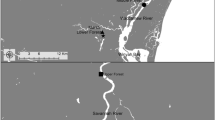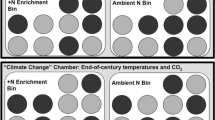Abstract
Many coastal plain wetlands receive nutrient pollution from agricultural fields and are particularly vulnerable to saltwater incursion. Although wetlands are a major source of the greenhouse gases methane (CH4) and nitrous oxide (N2O), the consequences of salinization for greenhouse gas emissions from wetlands with high agricultural pollution loads is rarely considered. Here, we asked how saltwater exposure alters greenhouse gas emissions from a restored freshwater wetland that receives nutrient loading from upstream farms. During March to November 2012, we measured greenhouse gases along a ~2 km inundated portion of the wetland. Sampling locations spanned a wide chemical gradient from sites receiving seasonal fertilizer nitrogen and sulfate (SO4 2−) loads to sites receiving seasonal increases in marine salts. Concentrations and fluxes of CH4 were low (<100 µg L−1 and <10 mg m−2 h−1) for all sites and sampling dates when SO4 2− was high (>10 mg L−1), regardless of whether the SO4 2− source was agriculture or saltwater. Elevated CH4 (as high as 1,500 µg L−1 and 45 mg m−2 h−1) was only observed on dates when air temperatures were >27 °C and SO4 2− was <10 mg L−1. Despite elevated ammonium (NH4 +) for saltwater exposed sites, concentrations of N2O remained low (<5 µg L−1 and <10 µg m−2 h−1), except when fertilizer derived nitrate (NO3 −) concentrations were high and N2O increased as high as 156 µg L−1. Our results suggest that although both saltwater and agriculture derived SO4 2− may suppress CH4, increases in N2O associated with fertilizer derived NO3 − may offset that reduction in wetlands exposed to both agricultural runoff and saltwater incursion.







Similar content being viewed by others
Explore related subjects
Discover the latest articles, news and stories from top researchers in related subjects.References
Anderson CJ, Lockaby BG (2012) Seasonal patterns of river connectivity and saltwater intrusion in tidal forested wetlands. River Res Appl 28:814–826. doi:10.1002/rra.1489
APHA (1998) Standard method for examination of water and wastewater. American Public Health Association Publication, APHA, AWWA, WEF, Washington, DC
Ardón M, Morse JL, Doyle MW, Bernhardt ES (2010) The water quality consequences of restoring wetland hydrology to a large agricultural watershed in the Southeastern Coastal Plain. Ecosystems 13:1060–1078. doi:10.1007/s10021-010-9374-x
Ardón M, Morse J, Colman B, Bernhardt ES (2013) Drought-induced saltwater incursion leads to increased wetland nitrogen export. Glob Chang Biol 19:2976–2985. doi:10.1111/gcb.12287
Barendregt A, Whigham DF, Baldwin AH (2009) Preface. In: Barendregt A, Whigham D, Baldwin A (eds) Tidal freshwater wetlands. Backhuys Publishers, Leiden, pp 1–10
Bartlett KB, Bartlett DS, Harriss RC, Sebacher DI (1987) Methane emissions along a salt marsh salinity gradient. Biogeochemistry 4:183–202. doi:10.1007/BF02187365
Bloom AA, Palmer PI, Fraser A et al (2010) Large-scale controls of methanogenesis inferred from methane and gravity spaceborne data. Science 327:322–325. doi:10.1126/science.1175176
Brettar I, Rheinheimer G (1991) Denitrification in the central Baltic—evidence for H2S-oxidation as motor of denitrification at the oxic-anoxic interface. Mar Ecol Prog Ser 77:157–169
Brinson MM, Eckles SD (2011) US Department of Agriculture conservation program and practice effects on wetland ecosystem services: a synthesis. Ecol Appl 21(3):S116–S127
Burgin AJ, Hamilton SK, Jones SE, Lennon JT (2012) Denitrification by sulfur-oxidizing bacteria in a eutrophic lake. Aquat Microb Ecol 66:283–293
Capone DG, Kiene RP (1988) Comparison of microbial dynamics in marine and freshwater sediments: contrasts in anaerobic carbon catabolism. Limnol Oceanogr 33(4):725–749
Carter LJ (1975) Agriculture: a new frontier in coastal North Carolina. Science 189:271–275. doi:10.1126/science.189.4199.271
Collins R, Jenkins A (1996) The impact of agricultural land use on stream chemistry in the middle hills of the Himalayas, Nepal. J Hydrol 185:137–150
Conrad R (1995) Methane emission from hypersaline microbial mats: lack of aerobic methane oxidation activity. FEMS Microbiol Ecol 16:297–305. doi:10.1016/0168-6496(95)00004-T
Corbett DR, Vance D, Letrick E et al (2007) Decadal-scale sediment dynamics and environmental change in the Albemarle Estuarine System, North Carolina. Estuar Coast Shelf Sci 71:771–729
Costanza R, d’Arge R, de Groot R et al (1997) The value of the world’s ecosystem services and natural capital. Nature 387:253–260. doi:10.1038/387253a0
Costanza R, Perez-maqueo O, Martinez ML et al (2008) The value of coastal wetlands for hurricane protection. AMBIO 37(4):241–248
Dahl TE (1990) Wetlands losses in the United States 1780s to 1980s. Department of the Interior, Fish and Wildlife Service, Washington, DC
Day RH, Williams TM, Swarzenski CM (2007) Hydrology of tidal freshwater forested wetlands of the Southeastern United States. In: Conner WH, Doyle TW, Krauss KW (eds) Ecology of tidal freshwater forested wetlands of the southeastern United States. Springer, Dordrecht, pp 29–63
De Steven D, Gramling JM (2012) Diverse characteristics of wetlands restored under the Wetlands Reserve Program in the Southeastern United States. Wetlands 32:593–604. doi:10.1007/s13157-012-0303-y
Fogg P, Sangster J (2003) Chemicals in the atmosphere: solubility, sources, and reactivity. John Wiley, New York
Forster P, Ramaswamy V, Artaxo P et al (2007) Changes in atmospheric constituents and in radiative forcing. In: Solomon S, Qin D, Manning M, Chen Z, Marquis M, Averyt KB, Tignor M, Miller HL (eds) Climate change 2007: the physical science basis. Contribution of Working Group I to the Fourth Assessment Report of the Intergovernmental Panel on Climate Change. Cambridge University Press, Cambridge
Gauci V, Matthews E, Dise N et al (2004) Sulfur pollution suppression of the wetland methane source in the 20th and 21st centuries. Proc Natl Acad Sci USA 101:12583–12587. doi:10.1073/pnas.0404412101
Golterman HL, Clymo RS (eds) (1969) Methods for chemical analysis of sulphide in fresh waters, vol 8. Blackwell Scientific, Oxford
Heimlich RE, Wiebe KD, Claassen R, Gadsby D, House RM (1998) Wetlands and agriculture: private interests and public benefits. Agricultural economic report. USDA, Washington, DC
Hopfensperger KN, Burgin AJ, Schoepfer VA, Helton AM (2014) Impacts of saltwater incursion on plant communities, anaerobic metabolism, and resulting relationships in a restored freshwater wetland. Ecosystems. doi:10.1007/s10021-014-9760-x
Hudson F (2004) Standard operating procedure: sample preparation and calculations for dissolved gas analysis in water samples using a GC headspace equilibration technique. RSKSOP-175 US. EPA, Washington, DC
Hyer KE, Hornberger GM, Herman JS (2001) Processes controlling the episodic streamwater transport of atrazine and other agrichemicals in an agricultural watershed. J Hydrol 254:47–66
IPCC (2012) Summary for policymakers. In: Field CB, Barros V, Stocker TF, Qin D, Dokken DJ, Ebi KL, Mastrandrea MD, Mach KJ, Plattner GK, Allen SK, Tignor M, Midgley PM (eds) Managing the risks of extreme events and disasters to advance climate change adaptation. A special report of Working Groups I and II of the Intergovernmental Panel on Climate Change. Cambridge University Press, Cambridge
Joye SB, Hollibaugh JT (1995) Influence of sulfide inhibition of nitrification on nitrogen regeneration in sediments. Science 270:623–625. doi:10.1126/science.270.5236.623
Kozlowski TT (1997) Responses of woody plants to flooding and salinity. Tree Physiology Monograph No. 1. Heron Publishing, Victoria
Livingston GP, Hutchinson GL (1995) Enclosure-based measurement of trace-gas exchange: applications and sources of error. In: Matson PA, Harriss RC (eds) Biogenic trace gases: measuring emissions from soil and water. Blackwell Science, Cambridge, pp 14–51
Marton JM, Herbert ER, Craft CB (2012) Effects of salinity on denitrification and greenhouse gas production from laboratory-incubated tidal forest soils. Wetlands 32:347–357. doi:10.1007/s13157-012-0270-3
Matson A, Pennock D, Bedard-Haughn A (2009) Methane and nitrous oxide emissions from mature forest stands in the boreal forest, Saskatchewan, Canada. Forest Ecol Manag 258(7):1073–1083
Megonigal J, Hines M (2003) Anaerobic metabolism: linkages to trace gases and aerobic processes. In: Holland HD, Turekian KK (eds) Treatise on geochemistry, biogeochemistry, vol 8., pp 317–424
Morse JL, Ardón M, Bernhardt ES (2012) Greenhouse gas fluxes in southeastern US coastal plain wetlands under contrasting land uses. Ecol Appl 22:264–280. doi:10.1890/11-0527.1
Neubauer SC (2012) Ecosystem responses of a tidal freshwater marsh experiencing saltwater incursion and altered hydrology. Estuaries Coasts. doi:10.1007/s12237-011-9455-x
Nisbet EG, Dlugokencky EJ, Bousquet P (2014) Methane on the rise—again. Science 343:493–495. doi:10.1126/science.1247828
O’Driscoll MA (2012) The 1909 North Carolina drainage act and agricultural drainage effects in eastern North Carolina. N C Acad Sci 128:59–73
Oh NH, Raymond PA (2006) Contribution of agricultural liming to riverine bicarbonate export and CO2 sequestration in the Ohio River basin. Glob Biogeochem Cycles 20:GB3012
Paerl HW, Bales JD, Ausley LW et al (2001) Ecosystem impacts of three sequential hurricanes (Dennis, Floyd, and Irene) on the United States’ largest lagoonal estuary, Pamlico Sound, NC. PNAS 98(10):5655–5660
Poffenbarger HJ, Needelman BA, Megonigal JP (2011) Salinity influence on methane emissions from tidal marshes. Wetlands 31(5):831–842
R Core Team (2012) R: A language and environment for statistical computing. R Foundation for Statistical Computing, Vienna, Austria. http://www.R-project.org/
Roseberg RJ, Christensen NW, Jackson TL (1986) Chloride, soil solution osmotic potential, and soil-pH effects on nitrification. Soil Sci Soc Am J 50(4):941–945
Segers R (1998) Methane production and methane consumption: a review of processes underlying wetland methane fluxes. Biogeochemistry 41:23–51
Senga Y, Mochida K, Fukumori R et al (2006) N2O accumulation in estuarine and coastal sediments: the influence of H2S on dissimilatory nitrate reduction. Estuar Coast Shelf Sci 67:231–238. doi:10.1016/j.ecss.2005.11.021
Seo DC, Yu K, Delaune RD (2008) Influence of salinity level on sediment denitrification in a Louisiana estuary receiving diverted Mississippi River water. Arch Agron Soil Sci 54:249–257
Smith VH, Joye SB, Howarth RW (2006) Eutrophication of freshwater and marine systems. Limnol Oceanogr 51(1 part 2):351–355
Verhoweven JTA, Arheimer B, Yin C, Hefting M (2006) Regional and global concerns over wetlands and water quality. Trends Ecol Evol 21(2):96–103
Weston NB, Giblin A, Banta G et al (2010) The effects of varying salinity on ammonium exchange in estuarine sediments of the Parker River, Massachusetts. Estuaries Coasts 33:985–1003. doi:10.1007/s12237-010-9282-5
Weston NB, Vile MA, Neubauer SC, Velinsky DJ (2011) Accelerated microbial organic matter mineralization following salt-water intrusion into tidal freshwater marsh soils. Biogeochemistry 102:135–151. doi:10.1007/s10533-010-9427-4
Yates TT, Si BC, Farrell RE, Pennock DJ (2006) Probability distribution and spatial dependence of nitrous oxide emission: temporal change in hummocky terrain. Soil Sci Soc Am J 70(3):753–762
Zedler JB (2003) Wetlands at your service: reducing impacts of agriculture at the watershed scale. Front Ecol Environ 1:65–72. doi:10.1890/1540-9295(2003)001[0065:WAYSRI]2.0.CO;2
Acknowledgments
We thank Steven Gougherty, Valerie Schoepfer, and Brooke Hassett for field and lab assistance, and Raven Bier for providing the first draft of Supplemental Fig. 1. Funding for this work was provided by NSF DEB 1216916.
Author information
Authors and Affiliations
Corresponding author
Electronic supplementary material
Below is the link to the electronic supplementary material.
Rights and permissions
About this article
Cite this article
Helton, A.M., Bernhardt, E.S. & Fedders, A. Biogeochemical regime shifts in coastal landscapes: the contrasting effects of saltwater incursion and agricultural pollution on greenhouse gas emissions from a freshwater wetland. Biogeochemistry 120, 133–147 (2014). https://doi.org/10.1007/s10533-014-9986-x
Received:
Accepted:
Published:
Issue Date:
DOI: https://doi.org/10.1007/s10533-014-9986-x




